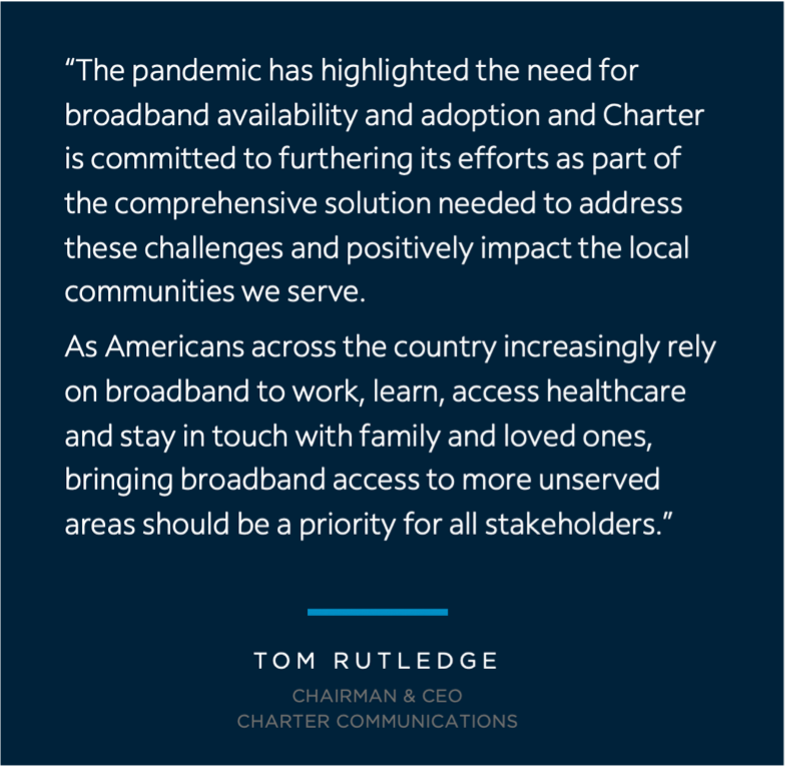Network Investment and Access
A $259 Million Initiative to Expand Broadband Availability to Unserved Indiana Homes and Small Businesses
March 3, 2021
Share Article:
Charter has announced plans to deliver gigabit high-speed broadband to approximately 54,000 unserved Indiana homes and small businesses, as estimated by the Federal Communications Commission (FCC). As part of this effort, more than $259 million will be invested in Indiana, which includes an expected private investment of at least $200 million by Charter and more than $59 million in support won by Charter in the FCC’s Rural Digital Opportunity (RDOF) auction. You can view a map of the Indiana expansion here. The effort is part of the company’s recently announced expected investment of approximately $5 billion — offset by $1.2 billion in RDOF support — to expand Charter's network to what the FCC estimates to be more than 1 million homes and small businesses in lower-density, mostly rural communities across 24 states that do not have access to broadband service of at least 25/3 Mbps.
The new initiative is in addition to Charter’s existing network expansion plans and builds upon the company’s long track record of expanding broadband access to unserved and underserved locations.
State leaders recognize the importance of rural broadband expansion to Indiana’s future. Of the announcement, Gov. Eric Holcomb said, “Charter’s move to expand broadband availability in Indiana will play an enormous role in ensuring all Hoosiers, particularly those living in rural areas, can access 21st-century online tools and services. Their significant investment will complement our state’s own nation-leading broadband program to help create jobs, build businesses and connect more people at a time when so many are still struggling from the effects of the pandemic.”
Sen. Todd Young remarked, “Rural broadband deployment has the power to transform Indiana communities, especially those that are underserved. Investing in this critical infrastructure will have meaningful and long-lasting benefits for education, telehealth, agriculture and jobs in our state.”
“Expanding internet access means expanding access to more and better jobs, educational resources for students and telehealth medical services for rural communities. Charter is making a great investment in Indiana’s future,” said Sen. Mike Braun.
A March 2019 study by the U.S. Chamber of Commerce Technology Engagement Center found that if Indiana rural businesses had “better access to digital technologies,” they could unlock future economic growth, including adding an estimated more than 16,000 jobs, increasing annual wages by an estimated more than $638 million and adding an estimated more than $2 billion in annual value to Indiana’s GDP. Charter’s investment in expanding broadband access will be an important step in increasing Hoosiers’ access to digital technologies and positioning Indiana for future growth.
Gigabit Broadband with No Data Caps or Modem Fees
The network Charter will build in these mostly rural areas will offer 1 Gbps high-speed broadband access to all newly served customer locations, with starting speeds of 200 Mbps, enabling consumers to engage in remote learning, work, telemedicine and other applications that require high-bandwidth, low-latency connectivity. These newly served customer locations also will benefit from Charter’s high-value Spectrum pricing and packaging structure, including its Spectrum Mobile™, Spectrum TV® and Voice offerings. Charter will continue to apply its customer-friendly policies in newly served regions, including no data caps, modem fees or annual contracts, combined with high-quality service provided by U.S.-based, insourced employees.
Preparation for the RDOF Phase I broadband buildout has already begun and will include Charter expanding its existing construction organization in order to focus on deployment of this new fiber-optic network. Charter expects to hire more than 2,000 employees and contractors nationwide to support the RDOF and future rural buildout initiatives, including local crews in state for network construction. Charter currently employs more than 400 people in Indiana, with employees already earning at least two times the federal minimum wage with a commitment to raising it to $20 an hour next year.

The FCC estimates Charter's major infrastructure investment will ultimately reach more than 1 million households and small businesses and will be completed on a rolling basis, with all customer locations expected to be connected within the six-year compliance window. Charter has established an online resource at SpectrumRuralExpansion.com, where consumers can learn more about the RDOF buildout. In the months ahead, the site will include the ability to determine whether specific residential or business locations will be part of the RDOF buildout. And in the future, the site also will allow prospective customers to request email or text message updates from Spectrum as the buildout progresses and more specific information becomes available. As buildouts near completion, Charter will contact customers to provide details about the Spectrum services available and activation time frames.
Timely Execution Depends on Prompt Permitting and Access to Utility Poles
The timely execution and potential reach of the buildout are dependent on several external factors, including the utility pole permitting and “make-ready” processes. With fewer homes and businesses in these areas, broadband providers need to access multiple poles for every new home served, as opposed to multiple homes per pole in higher-density settings. As a result, pole applications, pole replacement rules and their affiliated issue resolution processes are all factors that can have a significant impact on the length of time it takes to complete projects in these rural areas.
Rutledge added, “The stronger collaboration we have among broadband providers, state regulators, pole owners and utility companies, the faster we can connect these communities with high-speed internet services. We look forward to working with local municipalities, electric cooperatives, and investor-owned utilities to ensure that permits are obtained in a timely, fair and cost-effective fashion.”